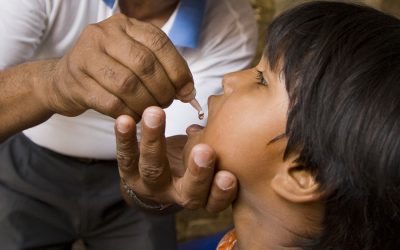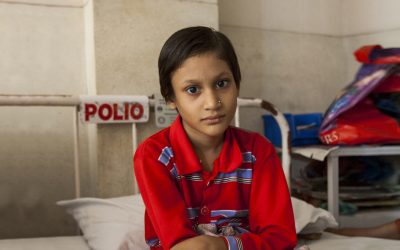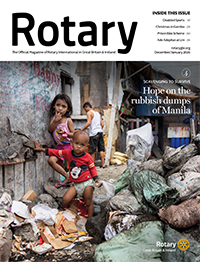Wild poliovirus (WPV) is the most commonly known form of the poliovirus. However, there is another form of polio that can spread within communities: circulating vaccine-derived poliovirus, or cVDPV.
Listen to this article
While cVDPVs are rare, they have been increasing in recent years due to low immunisation rates within communities. cVDPV type 2 (cVDPV2) are the most prevalent, with 959 cases occurring globally in 2020.
Notably, since the African Region was declared to have interrupted transmission of the wild poliovirus in August 2020, cVDPV are now the only form of the poliovirus that affects the African Region.
How do cVDPVs occur?
The oral polio vaccine (OPV) that has brought the wild poliovirus to the brink of eradication has many benefits: the live attenuated (weakened) vaccine virus provides better immunity in the gut, which is where polio replicates.
The vaccine virus is also excreted in the stool, and in communities with low-quality sanitation, this means that it can be spread from person to person and actually help protect the community.
However, in communities with low immunisation rates, as the virus is spread from one unvaccinated child to another over a long period of time (often over the course of about 12-18 months), it can mutate and take on a form that can cause paralysis just like the wild poliovirus.
This mutated poliovirus can then spread in communities, leading to cVDPVs.
While cVDPVs are rare, they have been increasing in recent years due to low immunisation rates within communities. cVDPV type 2 (cVDPV2) are the most prevalent, with 959 cases occurring globally in 2020.”
How is the Global Polio Eradication Initiative (GPEI) working to stop cVDPVs?
The cause of cVDPV is low immunisation rates. So, the best way to prevent them and stop them when there is an outbreak is to vaccinate children. The polio vaccine protects children whether the kind of polio is wild poliovirus or vaccine-derived poliovirus. Outbreaks, whether WPV or cVDPV, are usually rapidly stopped with two to three rounds of high-quality immunisation campaigns.
In addition to high-quality immunisation campaigns, the GPEI is working to deploy an improved outbreak response tool: the novel oral polio vaccine type 2, or nOPV2.
This vaccine is similar to mOPV2 (the monovalent oral polio vaccine type 2), the current outbreak response vaccine that is used when cVDPV type 2 outbreaks occur.
However, it contains improvements that help make the vaccine virus less likely to mutate and cause disease in communities with low immunisation rates – meaning that it can help reduce the risk of cVDPV2 outbreaks.
What are the other vaccine-derived polio viruses?
While cVDPVs affect communities and warrant public health action given the public health threat that they pose, there are other kinds of vaccine-derived polioviruses (VDPV) that are found in individuals and the environment.
Notably, since the African Region was declared to have interrupted transmission of the wild poliovirus in August 2020, cVDPV are now the only form of the poliovirus that affects the African Region.”
Tell me about immunodeficiency-related vaccine-derived poliovirus (iVDPV)
Prolonged replication of VDPVs has been observed in a small number of people with rare immune deficiency disorders. Because they are not able to mount an immune response, these people are not able to clear the intestinal vaccine virus infection, which is usually cleared within six to eight weeks.
They therefore excrete iVDPVs for prolonged periods. The occurrence of iVDPVs is very rare. Only 111 cases have been documented worldwide since 1962.
Of these, most stopped excretion within six months, or died.
What about ambiguous vaccine-derived polio viruses (aVDPV)?
When a vaccine-derived poliovirus is found in an individual that is not immunocompromised (i.e., it is not an iVDPV) and it is confirmed that this VDPV is not circulating within a community (i.e., it is not a cVDPV), then this case is referred to as an aVDPV.
Source: Global Polio Eradication Initiative


























































